Table of Contents
More Fulfillment Content
Get the latest e-commerce industry news, best practices, and product updates!
Table of Contents
More Fulfillment Content
Share This
Get the latest e-commerce industry news, best practices, and product updates!
Table of Contents
Share This
More Fulfillment Content
Get the latest e-commerce industry news, best practices, and product updates!
Direct fulfillment caters to consumer demands while helping brands redefine the retail shopping experience. Learn more here.
With the onset of a global pandemic leading to a surge in the urgency of digital transformation for retailers, the adoption of supply chain best practices for last-mile execution and order fulfillment continues to accelerate. As the sector gets more competitive with rising costs on last mile delivery, retailers are compelled to search for alternate cost-effective and efficient delivery options to ship products to consumers.
Read on to know more about direct fulfillment and how it is reshaping e-commerce fulfillment services.
What is Direct Fulfillment?
Direct fulfillment is when e-commerce companies make direct-to-customer (D2C) sales and ship the orders straight to the customers.
Due to the lack of intricate layers, direct fulfillment costs often boil down to being lower than most traditional retail methods. With the COVID-19 pandemic resulting in the exponential increase in demand for e-commerce, most vendors opted for direct fulfillment as a safety net to avoid disruption and losing out on sales during peak season.
Direct fulfillment is a pretty straightforward process where customer orders are taken in at the warehouse management system (WMS). They go directly to the fulfillment section, where the desired product inventory is situated.
WMS generates picklists (based on pin codes, order type, categories, etc.) and aids in selecting and packaging the product. The distribution partner’s pick-up schedule is automatically designated via API (application programming interface) integration, and the order is dispatched.

Drop Shipping vs. Direct Fulfillment
The terms ‘drop shipping’ and ‘direct fulfillment’ can be used interchangeably. Both refer to a retail system where the manufacturer ships their products directly to the customer, eliminating any third party.
In a regular drop shipping e-commerce business, the seller pays a higher wholesale price in exchange for the manufacturer taking care of shipping and warehousing. It lowers the seller’s risk because they only need to pay for the products the customers have already ordered, eliminating dead stock and lessening upfront costs for the seller.
Benefits of Direct Fulfillment
With the surge in e-commerce sales due to a global pandemic, D2C fulfillment or direct fulfillment has exploded, with more and more vendors opting for it. Most trusted D2C brands opt for this mode of shipping over the traditional retail methods. Some of the major benefits of direct fulfillment include:
Reduced Inventory and Warehouse Costs
Direct fulfillment allows vendors to exercise complete control over their branding, orders, and inventory. With the vendors maintaining ownership of their products, the retailers are able to significantly lower associated warehousing and inventory costs. Inventory-related investments have traditionally been a source of loss for many retailers, with them having to sell off excess inventory at overly discounted prices.
Ability to Increase SKU Listings
A stock-keeping unit (SKU) is a unique number or the scannable bar code found on the product labels of a retail store. It helps to identify a billable product in the inventory. The direct fulfillment model permits retailers to boost the product offerings on their website while eliminating the painstaking process of having to maintain an inventory. Retailers can simply keep on adding products by listing them on the website and hyperlinking the relevant items with their appropriate vendors.
Greater Control Over Product Listings
Direct fulfillment permits retailers to exercise complete control over their listings and the flexibility to promptly withdraw slow-moving items failing to gain traction or attract consumers. With the direct fulfillment model in place, there are zero possibilities of financial loss, as the retailer presumably maintains no inventory for such items. Thus, there is no risk of bearing the loss of unsold items.
Faster Deliveries to Consumers
With the retailer eliminated from partaking in the distribution process, the delivery cycle gets streamlined by direct fulfillment. There are no stops in between at a retailer’s distribution center, with the products moving directly to their end destination from the supplier or vendor. Thus the whole fulfillment process gets accelerated, and the consumers receive their orders faster than ever before.
Increased Foot Traffic to Physical Stores
Direct fulfillment can present customers with the choice of picking up their order shipments directly from the nearby physical store of a retailer as per convenience. A recent survey found that nearly half of the respondents preferred to ‘buy online, pick up in-store (BOPIS)’ in the preceding year – 40% of these consumers even made additional purchases at the store while dropping to pick up their orders.
Facilitated Handling for Large, Agile Products
Retailers selling large and heavy products can bypass having to concern themselves regarding any extra care required to ship or store such products. It is also applicable for retailers listing fragile and expensive computer equipment or items requiring special handling, such as extra cautioun, security, or temperature-controlled storage.
Retailer is Removed from the Fulfillment Process
With direct fulfillment, vendors are shipping items directly to consumers and eliminating any participation of retailers in the whole delivery process. This removes any added responsibility or cost on the part of the retailer. Instead, a qualified logistics provider supervises the entire process carried out by the product’s vendor.

The Right Time to Choose Direct Fulfillment
The COVID-19 pandemic has caused a fundamental shift in consumer buying behavior, leading to a remarkable increase in digital interactions. Recent trends suggest this increase is here to stay and likely to increase exponentially with time. This has put tremendous strain on the supply chain to complete online orders.
Due to the frequent delivery trips required, high volumes of orders, and the lack of in-house logistics infrastructure, fulfilling so many online orders via parcel carriers has become an expensive process. To tackle this situation, retailers have resorted to various countermeasures, such as urban micro-fulfillment centers, direct fulfillment, and store pick-ups.
Hence, this spike in demand for e-commerce purchases and the sudden shift from brick-and-mortar retail to online has compelled many retailers to reconsider traditional retail options. If you want to grow and expand your business and have logistical capabilities, now is the time to choose direct fulfillment.

Insights into Direct Fulfillment
Direct fulfillment addresses the supply chain issues faced by the e-commerce markets by creating a supply-on-demand framework. Here are some of the building blocks for the successful execution of the direct fulfillment model:
- Customer PO (purchase order) creation
- Back-order processing
- Maintaining POs
- Order lifecycle
- Inventory sync
- Real-time tracking
- Seamless integration
- Workflows
- Supplier dashboard

Direct to Consumer Strategies
According to the findings of the Global Brand Shopper Survey, direct-to-consumer or D2C strategy is the future of e-commerce retail, highlighted by the following statistics:
- 55% of the consumers preferred to deal directly with the manufacturer rather than any retailer
- 81% of the consumers stated they would prefer buying from a brand directly within the next 5 years
To formulate any successful D2C strategies, retailers need to mainly keep the following in mind:
- Centralize data under a single platform
- Determine the channels they need to focus on
- Re-engineer your shipment plan to align with your D2C strategy
Making Direct Fulfillment Work for Retailers
The key imperatives required for a retailer to build a successful direct fulfillment model are:
Integrated Supply Chain
Most retailer ecosystems have well-integrated cataloging and transacting applications, and it is the integration of downstream supply chains with supplier systems that need to be addressed. Internal systems of most suppliers, such as their transportation, warehouse management, and accounting, are not interconnected. In order to build a successful vendor model, API-enabled accurate information on the availability, location, and regularly updated product inventory data needs to be displayed at the point of purchase (that is, the retailer’s e-commerce website).
Control Inventory and Fulfillment Costs
Physically stocking all listed products within their premises or warehouses is hardly a practical or logical step with a sharp increase in expenditure. Instead, retailers must set up an inventory and fulfillment model that counteracts customer experience and profitability. Direct fulfillment permits retailers to meet market demands and satisfy customer expectations by using a virtual warehousing model, adjusting product offerings, expanding product listings, and eliminating inventory handling.
Address Legacy System Challenges
Even as the world expands and embraces digital e-commerce set-ups, many suppliers cannot adapt to these new practices due to their lack of in-house IT capabilities. As retailers aim to set priority initiatives to streamline the connections with their suppliers, these disparate systems need to be addressed to supervise prompt and reliable coordination with multiple parties.
Reverse Logistics Support for Returns Processing
Retailers need to enable suppliers to supervise and manage their own returns and eliminate the handling costs in the process. Complete transparency is required in the part of the last mile execution systems managing these processes.
Conclusion
Is Direct Fulfillment the solution for the near future? From a Return of Investment (ROI) perspective, the direct fulfillment model eliminates any requirement for an online retailer to stock or own the inventory listed on their website. The risks and the operational expenses involved in handling the inventory, such as stocking, insurance costs, and inventory carrying costs, get eliminated from the equation as well. Simultaneously, the end consumer experience is seamless, as the vendor is required to adhere to the packaging and branding guidelines while shipping the product.
Direct fulfillment thus helps boost top and bottom-line growth, makes the fulfillment process efficient, de-risks and diversifies the supply chain, and exceeds consumer expectations. Hence, it is undoubtedly the future of shipment methods in e-commerce.
Sign up today and leave the logistics to us
Sign up and we will get back to you within 24 hours to discuss what services would be best for your business needs. Or speak with us now and tell us what you need.
FAQs
Direct fulfillment is a fulfillment strategy where the vendor ships the items to the customer directly on behalf of the online retailer with whom the consumer placed the order.
Direct fulfillment allows retailers full control over their inventory without the need to stock the products listed on their website. Vendors ship the products directly to the consumer, thus eliminating any inventory-related or delivery-related costs on the part of the retailer while making the whole process more efficient.
Direct fulfillment requires the staff and resources of the retailer to concentrate on customer service and the fulfillment process, deviating from selling and expanding the business. The international shipping process may also get more complex with direct fulfillment.
Yes, the terms ‘direct fulfillment’ and ‘drop shipping’ can be used interchangeably, with both referring to a retail system where the vendor ships their products straight to the consumer, eradicating the involvement of any third party in between.
Backorder processing, real-time tracking, syncing the inventory, and creating and maintaining customer PO are some of the primary building blocks of the direct fulfillment model.